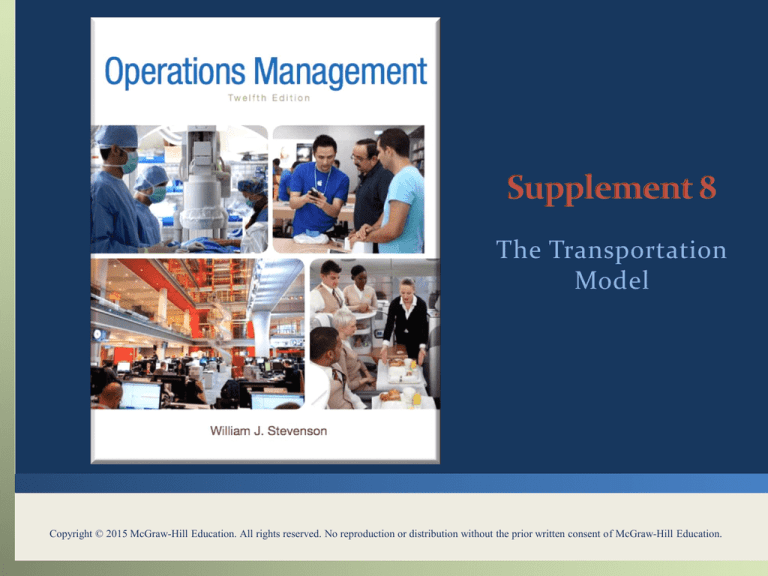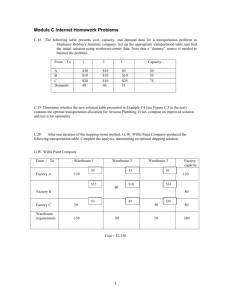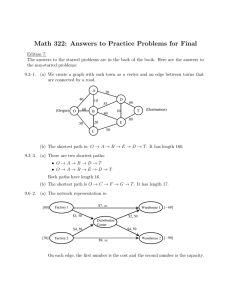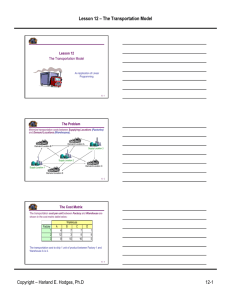
The Transportation
Model
Copyright © 2015 McGraw-Hill Education. All rights reserved. No reproduction or distribution without the prior written consent of McGraw-Hill Education.
You should be able to:
LO 8s.1 Describe the nature of a transportation problem
LO 8s.2 Solve transportation problems manually and
interpret the results
LO 8s.3 Set up transportation problems in the general linear
programming format
LO 8s.4 Interpret computer solutions
8S-2
Involves finding the lowest-cost plan for distributing a
stock of goods or supplies from multiple points of
origin to multiple destinations that demand the goods
D
S
(supply)
demand
D
demand
S
(supply)
D
demand
D
S
(supply)
LO 8s.1
demand
8S-3
Information requirements
A list of the origins and each one’s capacity or supply
quantity per period
2. A list of the destinations and each one’s demand per
period
3. The unit cost of shipping items from each origin to
each destination
1.
LO 8s.2
8S-4
Transportation model assumptions
The items to be shipped are homogeneous
2. Shipping cost per unit is the same regardless of the
number of units shipped
3. There is only one route or mode of transportation
being used between each origin and destination
1.
LO 8s.2
8S-5
Cost to ship one
unit from factory 1
to warehouse A
A
Warehouse
B
C
4
D
7
7
Supply
1
Factory
1
100
12
3
8
8
2
200
8
10
16
5
3
150
450
Demand
80
90
Warehouse B can use
90 units per period
LO 8s.2
Factory 1 can
supply 100 units
per period
120
160
Total capacity
per period
450
Total Demand per
period
8S-6
Intuitive Lowest-Cost Approach
Identify the cell with the lowest cost
2. Allocate as many units as possible to that cell, and
cross out the row or column (or both)
3. Find the cells with the next lowest cost from among the
feasible cells
4. Repeat steps (2) and (3) until all units have been
allocated
1.
LO 8s.2
8S-7
Warehouse
A
B
C
4
D
7
7
Factory
1
1
100
100
12
2
3
90
8
3
Supply
8
110
10
80
8
200
16
10
5
60
150
450
Demand
LO 8s.2
80
90
120
160
450
8S-8
Evaluating Stepping Stone Paths:
Start by placing a + sign in the cell you wish to evaluate.
2. Move horizontally (or vertically) to a cell that has units
assigned to it. Assign a minus sign (-) to it.
1.
It is OK to pass through an empty cell or a completed cell without stopping.
Choose a cell that will permit your next move to another completed cell.
Change direction and move to another completed cell. Assign a plus sign
(+) to the cell.
3.
Continue the process until a closed path back to the original
cell can be completed.
LO 8s.2
8S-9
Warehouse
4–1+5–8=0
A
B
C
4
Factory
1
7
7
Supply
1
(-)
100
(+)
12
2
3
90
8
3
D
8
8
110
10
(-)
80
100
200
16
10
5
(+)
60
150
450
Demand
LO 8s.2
80
90
120
160
450
8S-10
Warehouse
A
B
C
4
7
Factory
1
7
10
12
2
10
Supply
1
100
90
3
90
8
3
D
8
8
200
110
16
80
5
70
150
450
Demand
LO 8s.2
80
90
120
160
450
8S-11
Warehouse
A
B
C
4
Factory
1
0
7
+7
3
80
+4
1
8
110
10
Supply
100
90
3
90
8
7
10
+5
12
2
D
8
16
+5
200
+6
5
70
150
450
Demand
LO 8s.2
80
90
120
160
450
8S-12
xij the number of units to ship from factory i to warehouse j
Decision Variables
Minimize
where
i 1, 2, and 3 and j A, B, C, and D
4 x1 A 7 x1B 7 x1C 1x1D 12 x2 A 3x2 B 8 x2C
8 x2 D 8 x3 A 10 x3 B 16 x3C 5 x3 D
Subject to
Supply (rows)
x1 A x1B x1C x1D 100
x2 A x2 B x2C x2 D 200
x3 A x3 B x3C x3 D 150
Demand (columns)
x1 A x2 A x3 A 80
x1B x2 B x3 B 90
x1C x2C x3C 120
x1D x2 D x3 D 160
xij 0 for all i and j
LO 8s.3
8S-13
Transportation problems can be solved manually in a
straightforward manner
Except for very small problems, solving the problem manually can
be very time consuming
For medium to large problems, computer solution techniques are
more practical
A variety of software packages are available for solving
the transportation model
Some require formulating the problem as a general LP model
Others allow data entry in a more simple, tabular format
LO 8s.4
8S-14
LO 8s.4
8S-15








